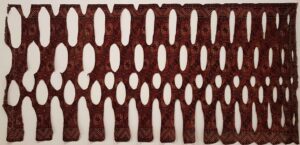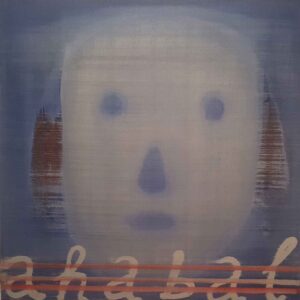
vGabriel Klamser: 'Ahabal' (2000)

Given the chance to visit the Tel Aviv Museum of Art and to consider the work and place of contemporary Israeli artists, my mind was filled with expectation. Surely the people who had produced Camille Pisarro and Marc Chagall, rumours about Rembrandt’s Jewish ancestry, Mark Rothko, Amedeo Modigliani, Leon Golub, Naum Gabo, Lucian Freud, Sonia Delaunay and so many others, would hold fascinating insights into western cultural development. Surely the energy with which they had built an entire country, and the exquisite and unique architecture they had created would spill over into sculpture, drawing and painting? I was wrong.
I wasn’t surprised to see the galleries named after the families who had endowed the museum. Nor surprised at the impressive weight of the Impressionist and Post-impressionist exhibitions. There can be few museums in the world which can boast of having four new Picassos in their collection donated ‘recently’ – and what a joy to see an early Picasso from 1899-1900. There was one large Giacometti – a beautiful piece – but it showed the fundamental weakness of the museum; the reliance of a relatively poor country on the donations and taste of wealthy collectors from America. The links with America have had positive political dividends, but culturally the association has impoverished the country’s artists. With New York on visual-arts life-support, copying it makes little sense if your aim is to lay down a new strata of culture.

Israel lost much in being disconnected from the land for thousands of years. The growth of an indigenous art practice has been lost and in its place they rely upon the wealthy collectors around the world to impart to them their taste (largely western, though Jewish people have lived in almost every country on Earth). They are also heavily influenced by the fashions of the West, as set in New York and London. That is the only reason the Chicagoan Theaster Gates with what that looked like a children’s practice alphabet – was on show. Chicago also features in the climate change show on the ground floor with its design for a carbon neutral city of the future. It is also the reason why a whole gallery is given to the strange idea of sending descriptions of fruits and vegetables to illustrators around the world and asking them to draw what the words conjure, without being told what they are describing. The exercise results in a vegetable version of the kinds of bestiary produced in the late Middle Ages by artists who had never seen half the animals they were drawing. Interesting? Not very. Popular? Probably, but only for the bored. It also explains why the modern gallery of Israeli artists was a filtered down version of New York, a disfigured reliquary of a generation of philosophy that led Donald Kuspit to comment that there are so many choices now everything is art, artists are lost. But the museum states that these works, shiny installations and carpets cut to pieces, reflect the contemporary art scene and even the history of Israeli art. Maybe they do but if this is so, you can see this stuff in any art fair (and art fairs have had their day) because it is all the same.
The observer in Tzfat knows immediately that there is an artists’ colony there where Jewish people are talking to Jewish people. There is nothing wrong with that, it is a religious town with no pretensions to be putting the nation on show to other nations. The pre-occupations of the artists are the accoutrements of Judaism, and the centrality of family in the religion. Intermixed with portraits of kindly rabbis. The Museum of Art in Tel Aviv does not have their excuse. Gabriel Klasmer’s gift from 2014 should be given back. Ariel Schlesinger’s wood burnt carpet is a meaningless piece, as philosophically full of holes as the traditional carpet. The installations are worthy of being on the free exhibition floors of Tate Modern, London. You could interchange them without breaking an intellectual sweat. You cannot go from Monet and Renoir to artists looking like they are practising for the position of marketing director at the Saatchi Gallery, and argue you are in an equal tradition.
Many years ago listening to the programme about the founding of the MacDonald’s chain, I heard the story that the accountant who advised the founder told him his biggest problem was that he didn’t know what business he was in. The founder thought he was in the food business but the accountant pointed out that, as a franchise, he was in the real estate business.
This is a vital lesson for artists to learn. The high end art world is not in the art business, they are in the marketing business. Israeli artists have to get away from such marketing. They will only be able to fill the hiatus of two thousand years with a bravura creativity and a bravura honesty. Some of which is found in the graffiti which is so prevalent in Tel Aviv they organise tours to visit the areas where they abound: Neve Tzedek and Florentin. Interspersed with small coffee shops and plenty of restaurants it has the feel of a cultural neighbourhood full of energy and appeal. But a lot of it is also messy and awkward. That said, it feels strange to be more visually drawn to street art than museum exhibitions. As if there is a cultural betrayal in progress.
Daniel Nanavati
Volume 34 no 4 March/April 2020 pp 7-8


It was about time someone wrote about the art scene in Israel, though the article is not much of a surprise considering….
(I would say more, but I don’t want to risk having my comment moderated like they do in the Daily Mail.)
I would be happy for you to say more. There is much to the malaise the art world sickens with throughout the western world but only by discussing it will new thinkers arise to create finer works.
What a sad reality you portray! Where do the Israeli get their inspiration, their creativity? At least their food is delicious; that too could be considered art.